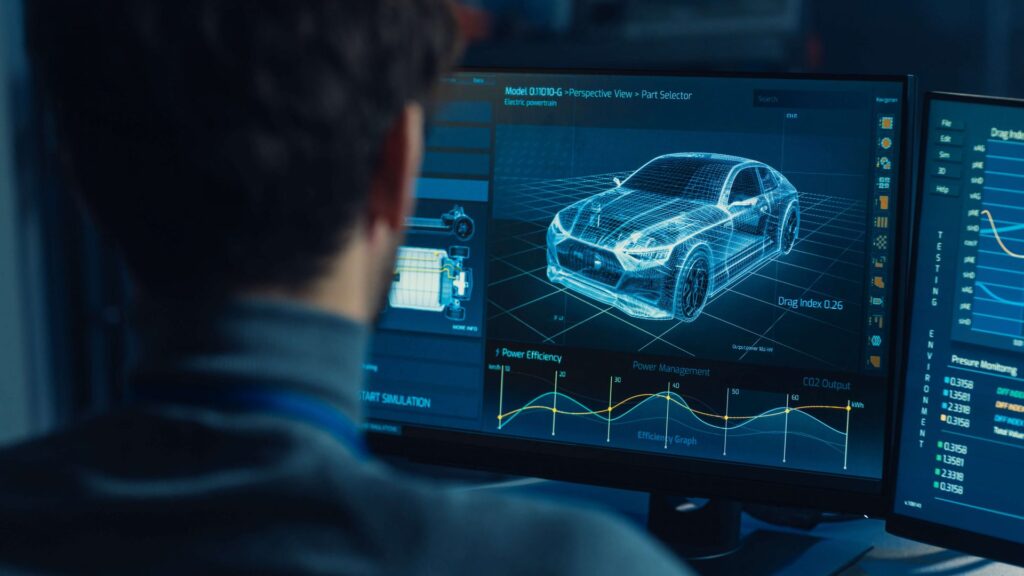Driver Monitoring Systems to become mandatory under new EU and US road safety regulations
In recent years, lawmakers across the globe noticed the scale of serious car crashes related to driver fatigue or distraction and put a strong focus on improving road safety in this regard. They took a step beyond social awareness campaigns and started seeking a solution in the newest technologies. Recent road safety regulations in the EU and US have paved the way for Driver Monitoring Systems to become mandatory in all new vehicles in the future, on the EU market as early as 2022, to ensure driver’s alertness through comprehensive vehicle systems analysis.
Let’s take a closer look at the scale of fatigue-related car accidents to better understand why a Driver Monitoring System can be a real game-changer. Then we’ll review the new regulations and see how such a solution can help prevent car crashes in practice.
What is a Driver Monitoring System?
A Driver Monitoring System (DMS) is a cutting-edge vehicle safety technology designed to enhance road safety by keeping a vigilant eye on the driver. Utilising advanced computer vision and machine learning algorithms, a DMS continuously monitors a driver’s behaviour and attention levels while they are behind the wheel. This sophisticated system employs a combination of cameras, sensors, and software to track various aspects of the driver’s condition, including eye movements, head position, and body posture, as well as their steering inputs and the vehicle’s position on the road.
The primary objective of a DMS is to prevent accidents caused by driver distraction, drowsiness, and fatigue. By providing timely alerts and interventions, the system helps ensure that drivers remain focused on the road ahead, thereby significantly reducing the risk of collisions. As road safety regulations evolve, the integration of DMS into new vehicles is set to become a standard feature, marking a significant step forward in the quest for safer highways.
The scale of driver drowsiness problem in road traffic
According to the road safety thematic report on fatigue driving prepared by the European Commission on January 21, it is estimated that fatigue contributes to about 15-20% of severe road accidents. The estimates get even higher for (international) truck drivers, (night) shift drivers, taxi drivers and young men.
On average, every 1 in 5 car drivers reported that they felt so sleepy behind the wheel that they struggled to keep their eyes open and focus on the road (based on the E-Survey of Road users’ Attitudes – ESRA). Additionally, over 50% of long-distance drivers claim that they fell asleep or were close to falling asleep while driving at some point.
Fatigue may have various backgrounds, but no matter if it’s task-related or sleep-related, it leads to the same effects for drivers: slower reaction times, less precise steering (frequent swerving), randomly changing headway distance and speed. Various studies indicate that the risk of car crashes increases when a driver is tired: from 1.29 to even 3.4 times on average in comparison to no-fatigue driving.
However, the real scale of fatigue-related road crashes is hard to assess, mainly because drivers usually do not admit that they have fallen asleep or had difficulties in remaining focused on driving due to tiredness. So far, the only potential evidence that the accident was caused by fatigue driving have been the crash characteristics, for example, no skid marks. The results of fatigue-related accidents in most cases are very serious because drivers don’t brake on time or at all while going at high speed.
Can fatigue-related accidents be prevented? Certainly. So far, only by adhering to the rules and regulations, but in the very near future, the countermeasures will be much more active thanks to the cutting-edge technology. Driver Monitoring Systems are on their way to becoming mandatory in all newly produced vehicles in Europe and the US, significantly improving driver behaviour.

The introduction of new regulations in the EU and US
So far, there were only regulations related to fatigue driving applicable to professional drivers, but not all users. For example, in Europe, there is the Regulation (EC) No 561/2006 of the European Parliament and of the Council of 15 March 2006 on the harmonisation of certain social legislation relating to road transport. This regulation set the maximum driving time and minimum rest period for passenger and cargo transport. The enforcement of such regulations is conducted through on-road controls and tachographs.
These preventive control measures aren’t always effective enough, though. Often drivers understate their drowsiness level and sit behind the wheel anyway. Tachographs help keep control over the driving time, but not over the sleepless-night-related fatigue, drowsiness caused by monotonous landscape or simple distraction. Preventing those is a matter of seconds before the accident happens. That was one of the reasons for the EU and US lawmakers to introduce new regulations regarding measures to prevent fatigue-related crashes and increase road safety, including the implementation of advanced driver assistance systems.
Regulation (EU) 2019/2144 of the European Parliament and of the Council
According to Chapter II, Article 6 of the Regulation, motor vehicles shall be equipped with intelligent speed assistance, alcohol interlock installation facilitation, driver drowsiness and attention warning, advanced driver distraction warning, emergency stop signal, reversing detection and event data recorder.
The new regulation also points out that the advanced braking systems, intelligent speed assistance, emergency lane-keeping systems, driver drowsiness and attention warning and reversing detection have a high potential to reduce casualty numbers significantly, thus contributing to overall highway safety.
The regulation states that the data should be processed in a close-loop system in the event data recorder, in accordance with the Union data protection law. The data should only be recorded and retained if it’s necessary to the purpose for which it was recorded.
The regulation was introduced in November 2019 and will apply to all new vehicles placed on the EU market, registered or entered into service from July 6, 2022.
Read the Regulation (EU) 2019/2144 in full here >>
The Moving Forward Act
Also, the US government sees the potential of driver monitoring systems for improving road safety. In the recently approved Moving Forward Act there’s a passage devoted to advanced crash system research including „Driver monitoring systems that will minimize driver disengagement, prevent automation complacency, and account for foreseeable misuse of the automation.”
Moreover, the research should also cover lane keeping assistance systems and automatic crash data notification systems. The former will help steer a vehicle to keep it within its driving lane. The latter will notify emergency services about a crash in a way that allows for assessment of potential injuries and emergency response. The anonymized data will also be gathered for the purpose of safety research and statistical analysis.
Although Moving Forward Act is not yet a law, there’s a high chance it will come into force in the nearest future. It was already approved by the House of Representatives on July 1, 2021. Now it awaits to be considered by the Senate.
The Stay Aware For Everyone [SAFE] Act
In 2020 two US senators introduced a bill to direct the Secretary of Transportation to conduct research on how driver monitoring systems can minimize or even eliminate driver distraction and disengagement, automation complacency and misuse of driver-assist system. If research proves that driver monitoring systems are effective, then they’ll become mandatory in every vehicle.
You can download a copy of the SAFE Act at this link >>
How Driver Monitoring Systems work
Driver Monitoring Systems are typically equipped with a camera mounted on the steering column or dashboard, strategically positioned to capture clear images of the driver’s face and eyes. This camera uses infrared light to illuminate the driver’s face, enabling it to function effectively even in low-light conditions. The captured images are then processed by sophisticated software that employs machine learning algorithms to detect signs of distraction, drowsiness, or fatigue.
The system monitors several key indicators to assess the driver’s state:
Eye gaze: By tracking the driver’s eye movements, the system determines whether they are paying attention to the road ahead.
Head position: The system observes the driver’s head position to detect if they are nodding off or looking away from the road.
Steering inputs: Analyzing the driver’s steering inputs helps the system identify erratic or inconsistent movements that may indicate a lack of focus.
Vehicle position: The system tracks the vehicle’s position on the road to detect if the driver is drifting out of their lane.
When the system detects any signs of distraction, drowsiness, or fatigue, it promptly provides an alert to the driver. This alert can take various forms, such as an audible beep, a visual warning on the dashboard, or a vibrating steering wheel. In more advanced systems, the DMS may even intervene by taking control of the vehicle, such as applying the brakes or adjusting the steering, to prevent an accident.

How can driver monitoring systems actually prevent accidents?
We can answer this question based on our own experience with developing such a system. Our Innovation Lab team has been working on this solution in recent months. The result is a Driver Status Monitoring system that uses a set of cameras that currently monitor the driver’s eyes/irises and face and in the future will measure human condition such as pulse, blood oxidation and temperature without on-body sensors. AI and proprietary solution algorithms for sensor fusion analyse the driver’s drowsiness or distraction level based on the classification in time – closed, mid-closed, mid-open, open, or no eyes detected (when a driver is not looking at the road).
If the driver status monitoring system detects that eyes are closed for at least 3 seconds or when no eyes are detected, the appropriate warning alarm is played through speakers. In the future, there may also be a possibility to stop the car or call help.
Here you can read about our Driver Monitoring System in more detail >>
Implementation and integration challenges
Implementing and integrating Driver Monitoring Systems into vehicles presents several challenges that must be addressed to ensure their effectiveness. One of the primary challenges is the technical complexity involved. DMS relies on advanced computer vision and machine learning algorithms to accurately detect and interpret driver behaviour. Developing and fine-tuning these algorithms to work reliably in real-world conditions is a significant technical undertaking.
Another challenge is the placement of sensors and cameras. These components must be positioned in a way that provides a clear and unobstructed view of the driver’s face and eyes. Additionally, the system must be capable of functioning in a variety of lighting conditions, including low light and glare, which can affect the accuracy of the monitoring.
Driver acceptance is also a critical factor. Some drivers may be hesitant to use a system that continuously monitors their behaviour, perceiving it as intrusive. Therefore, it is essential to educate drivers on the benefits of DMS and how it can enhance their safety on the road.
Finally, regulatory requirements must be met. Driver Monitoring Systems must comply with standards set by organisations such as the National Highway Traffic Safety Administration (NHTSA) and the European New Car Assessment Programme (Euro NCAP). Ensuring compliance with these regulations is crucial for the widespread adoption of DMS.
Interested in DMS technology? Connect with our expert via the form below to explore tailored solutions and get answers to all your questions.
About the author
We’ll help you implement automotive safety standards. Contact our expert.
RECOMMENDED ARTICLES




